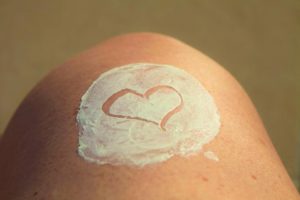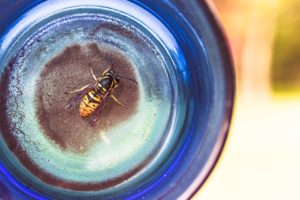In order to have the most enjoyable, healthy, and eco-friendly experience as possible this summer, we want to share some important information regarding the following “backyard essential” items, as well as give you the opportunity to make them yourself! As with many other store-bought products, some sunscreens and bug repellents are made with dangerous chemicals that are unsafe to living things and the environment. Do your research before buying the products you need, or make them yourself when you can.
SUNSCREEN
Environmental Working Group (EWG) is a non-profit, research and advocacy organization that drives consumer choice and civic action regarding human health and the environment. They do a lot of research around sunscreen, including an annual guide which highlights some of the major misconceptions and health concerns.
- There’s no conclusive proof that sunscreens prevent most skin cancer
- Don’t be fooled by high SPF
- The common sunscreen additive vitamin A may speed development of skin cancer
- European sunscreens provide better UVA protection
- Sunscreen doesn’t protect skin from all types of sun damage
- Some sunscreen ingredients disrupt hormones and cause skin allergies
- Mineral sunscreens contain nanoparticles
- If you avoid sun, check your vitamin D levels
“Two-thirds of the products we examined offer inferior sun protection or contain worrisome ingredients like oxybenzone, a hormone disruptor, or retinyl palmitate, a form of vitamin A that may harm skin. And despite scant evidence, the government still allows most sunscreens to claim they help prevent skin cancer. Over the course of 12 years, EWG has uncovered mounting evidence that one common sunscreen chemical, oxybenzone, poses a hazard to human health and the environment. It is an allergen and a hormone disruptor that soaks through skin and is measured in the body of nearly every American.” – EWG, 12th Annual Sunscreen Guide
 So, what’s your best choice this summer?… First of all, wear proper and protective clothing outdoors (including sunglasses and hats), drink plenty of water (in your reusable bottle of course!), and take breaks in the shade. Do your research for the healthiest brands of sunscreen available for you and your family. Did you know you can also make your own natural sunscreen? See this Treehugger blog for recipes: 3 Natural DIY sunscreen recipes to make at home, for cheap (Video).
So, what’s your best choice this summer?… First of all, wear proper and protective clothing outdoors (including sunglasses and hats), drink plenty of water (in your reusable bottle of course!), and take breaks in the shade. Do your research for the healthiest brands of sunscreen available for you and your family. Did you know you can also make your own natural sunscreen? See this Treehugger blog for recipes: 3 Natural DIY sunscreen recipes to make at home, for cheap (Video).
Already have a sunburn?…
DIY Natural After Sun Cooling Cream (4oz)
- 1/4 cup aloe vera
- 5 drops pure jojoba oil
- 1 tablespoon organic, unrefined shea butter (warmed so that it is very soft)
- 1 tablespoon organic coconut oil (warmed so that it is very soft)
- 10 drops peppermint essential oil
- 5 drops lavender essential oil
- 5 drops frankincense essential oil
BUG REPELLENT
EWG has concluded that although DEET certainly isn’t perfect, its safety profile is actually better than a lot of people think. Because it is highly effective, reasonably safe, and has been used billions of times, they concluded it’s a reasonable choice when you need a repellent that really works. Since there are still some concerns over DEET, EWG also recommends several good alternatives, including Picardin, IR 3535 and Oil of Lemon Eucalyptus. If you want to use DEET, skip the high concentrations. Opt for 7 -10% if you only need a few hours of protection and 20 – 30% for a full day. Got kids? Check out this detailed recommendation here. And always follow basic precautions when using any bug repellent.
DIY Natural Bug Spray
Ingredients:
- 30 drops geranium essential oil
- 30 drops citronella essential oil
- 20 drops lemon eucalyptus essential oil
- 20 drops lavender essential oil
- 10 drops rosemary essential oil
- 1 Tablespoon vodka or rubbing alcohol
- 1/2 cup Natural Witch Hazel
- 1/2 cup water (or vinegar)
- 1 teaspoon of vegetable glycerin (optional)
Mason Jar Luminaries: Homemade Bug Repellent
Materials:
- 2-8 oz Mason jars
- 1-16 oz Mason jar
- 40 drops rosemary essential oil
- 1 lemon
- 2 key limes or 1 lime
- 8 fresh rosemary sprigs
- 3 tea light candles
- 32 oz water
DIY Wasp Trap
Please note that although a wasp sting isn’t pleasant (and I’ve had my fair share over the years), I don’t endorse killing them. Nonetheless, people still do (and rightly so if they have severe allergies), and I would rather highlight the following DIY wasp traps instead of resorting to something HORRIBLE like this …
 Here is a how-to guide for making a wasp trap, or take it to the next level with this decorative wine bottle wasp trap for something a little more snazzy! Remember to use household and/ or recyclable items! There’s no need to create any unnecessary waste.
Here is a how-to guide for making a wasp trap, or take it to the next level with this decorative wine bottle wasp trap for something a little more snazzy! Remember to use household and/ or recyclable items! There’s no need to create any unnecessary waste.
Remember to Leave no Trace While in the Outdoors!




Recent Comments